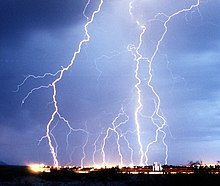User:Mr. Ibrahem/Lightning injury
| Mr. Ibrahem/Lightning injury | |
|---|---|
| Other names | Effects of lightning |
 | |
| Multiple lightning bolts strike a populated area. | |
| Specialty | Emergency medicine |
| Usual onset | 20 to 45 year old males[1] |
| Types | Direct strikes, side splash, contact injury, ground current[1] |
| Causes | Lightning strike[1] |
| Diagnostic method | Based on history of the injury and examination[1] |
| Prevention | Avoiding the outdoors during a thunderstorm[2] |
| Treatment | CPR, artificial ventilation[1] |
| Frequency | 240,000 a year[1] |
| Deaths | 24,000 a year[1] |
Lightning injuries are injuries caused by a lightning strike.[3] Initial symptoms may include heart asystole and respiratory arrest.[1] While the asystole may resolve spontaneously fairly rapidly, the respiratory arrest is typically more prolonged.[1] Other symptoms may include burns and blunt injuries.[1] Of those who survive about 75% have ongoing health problems as a result, such as cataracts and hearing loss.[1] If death occurs it is typically from either an abnormal heart rhythm or respiratory failure.[1]
Lighting injuries are divided into direct strikes, side splash, contact injury, and ground current.[1] Ground current make up about half of cases and occurs when the lightning strikes nearby and travels to the person through the ground.[1] Side splash makes up about a third of cases and occurs when lightning strikes nearby and jumps through the air to the person.[1] Contact injury occurs when the person is touching the object that is hit.[1] Direct strikes make up about 5% of injuries.[1] The mechanism of the injuries may include electrical injury, burns from heat, and mechanical trauma.[1] Diagnosis is typically based on history of the injury and examination.[1]
Prevention includes avoiding being outdoors during a thunderstorm.[2] If avoiding being outdoors is unavoidable crouching low is recommended.[2] When indoors the use of devices connected to electrical outlets and contact with water is not recommended.[2] Among those who appear in cardiac arrest and have no central pulse, cardiopulmonary resuscitation (CPR) should be started.[1] In those who have a central pulse but are not breathing artificial ventilation, such as mouth to mouth, is recommended.[1][4]
It is estimated that lightning injuries occur 240,000 times a year with 24,000 deaths.[1] Areas with mountainous terrain and moisture-heavy airflow, such as Central Africa, have the highest rates of lightning strikes.[5] Among pregnant women who are hit by lightning, the death of the baby occurs in about half.[1] In the United States about 1 in 10,000 people is hit by lightning during their lifetime.[1] Males are affected 4 times more often than females.[1] The age group most commonly affected is 20 to 45 years old.[1]
References[edit]
- ^ a b c d e f g h i j k l m n o p q r s t u v w x y z Jensen, JD; Vincent, AL (January 2019). "Lightning Injuries". StatPearls. PMID 28722949.
- ^ a b c d "Lightning Safety Tips". CDC. 23 January 2019. Archived from the original on 7 November 2019. Retrieved 11 November 2019.
- ^ Mallinson, T (2013). "Understanding the correct assessment and management of lightning injuries". Journal of Paramedic Practice. 5 (4): 196–201. doi:10.12968/jpar.2013.5.4.196.
- ^ "First Aid Recommendations Lightning". CDC. 23 January 2019. Archived from the original on 21 October 2019. Retrieved 11 November 2019.
- ^ Davis, Chris; Engeln, Anna; Johnson, Eric L.; McIntosh, Scott E.; Zafren, Ken; Islas, Arthur A.; McStay, Christopher; Smith, William R.; Cushing, Tracy; Wilderness Medical Society (December 2014). "Wilderness Medical Society practice guidelines for the prevention and treatment of lightning injuries: 2014 update". Wilderness & Environmental Medicine. 25 (4 Suppl): S86–95. doi:10.1016/j.wem.2014.08.011. ISSN 1545-1534. PMID 25498265.
